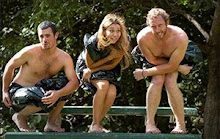Henry Lawson is one of Australia’s most popular Poets and Storytellers. Writing at the turn of the last century, his body of work included short stories, poetry, essays, humorous observations and recollections, consistently brilliant and inspired. A colourful character, sent to the Outback initially to ‘dry-out’ by his city editor, which he never quite succeeded in doing, he chronicled with wit and understanding, insight and candour, honesty and a wry, knowing grin, the characters he encountered, the lives they lead, and the hardships they faced living in the harshness of the Australian bush.
The Romance of the Swag
(ed. vers)
THE Australian swag fashion is the easiest way in the world of carrying a load… The Australian swag was born of Australia and no other land - of the Great Lone Land of magnificent distances and bright heat; the land of self-reliance, and never-give-in, and help-your-mate. The grave of many of the world's tragedies and comedies-royal and otherwise. The land where a man out of employment might shoulder his swag in Adelaide and take the track, and years later walk into a hut on the Gulf…
The swag is usually composed of a tent "fly" or strip of calico (a cover for the swag and a shelter in bad weather…), a couple of blankets, blue by custom and preference, as that colour shows the dirt less than any other (hence the name "bluey" for swag), and the core is composed of spare clothing and small personal effects. To make or "roll up" your swag: lay the fly or strip of calico on the ground, blueys on top of it; across one end, with eighteen inches or so to spare, lay your spare trousers and shirt, folded, light boots tied together by the laces toe to heel, books, bundle of old letters, portraits, or whatever little knick-knacks you have or care to carry, bag of needles, thread, pen and ink, spare patches for your pants, and bootlaces. Lay or arrange the pile so that it will roll evenly with the swag (some pack the lot in an old pillowslip or canvas bag), take a fold over of blanket and calico the whole length on each side, so as to reduce the width of the swag to, say, three feet, throw the spare end, with an inward fold, over the little pile of belongings, and then roll the whole to the other end, using your knees and judgment to make the swag tight, compact and artistic; when within eighteen inches of the loose end take an inward fold in that, and bring it up against the body of the swag. There is a strong suggestion of a roley-poley in a rag about the business, only the ends of the swag are folded in, in rings, and not tied. Fasten the swag with three or four straps, according to judgment and the supply of straps. To the top strap, for the swag is carried (and eased down in shanty bars and against walls or veranda-posts when not on the track) in a more or less vertical position--to the top strap, and lowest, or lowest but one, fasten the ends of the shoulder strap (usually a towel is preferred as being softer to the shoulder), your coat being carried outside the swag at the back, under the straps.
To the top strap fasten the string of the nose-bag, a calico bag about the size of a pillowslip, containing the tea, sugar and flour bags, bread, meat, baking-powder and salt, and brought, when the swag is carried from the left shoulder, over the right on to the chest, and so balancing the swag behind. But a swagman can throw a heavy swag in a nearly vertical position against his spine, slung from one shoulder only and without any balance, and carry it as easily as you might wear your overcoat. Some bushmen arrange their belongings so neatly and conveniently, with swag straps in a sort of harness, that they can roll up the swag in about a minute, and unbuckle it and throw it out as easily as a roll of wall-paper, and there's the bed ready on the ground with the wardrobe for a pillow. The swag is always used for a seat on the track; it is a soft seat, so trousers last a long time. And, the dust being mostly soft and silky on the long tracks out back, boots last marvellously. Fifteen miles a day is the average with the swag, but you must travel according to the water: if the next bore or tank is five miles on, and the next twenty beyond, you camp at the five-mile water to-night and do the twenty next day. But if it's thirty miles you have to do it.
Travelling with the swag in Australia is variously and picturesquely described as "humping bluey," "walking Matilda," "humping Matilda," "humping your drum," "being on the wallaby," "jabbing trotters," and "tea and sugar burglaring," but most travelling shearers now call themselves trav'lers, and say simply "on the track," or "carrying swag."
And there you have the Australian swag…
Saturday, January 31, 2009
Subscribe to:
Post Comments (Atom)

No comments:
Post a Comment